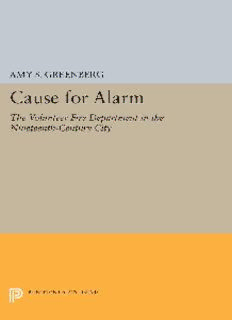
Cause for Alarm: The Volunteer Fire Department in the Nineteenth-Century City PDF
Preview Cause for Alarm: The Volunteer Fire Department in the Nineteenth-Century City
Cause for Alarm Cause for Alarm THE VOLUNTEER FIRE DEPARTMENT IN THE NINETEENTH-CENTURY CITY Amy S. Greenberg PRINCETON UNIVERSITY PRESS PRINCETON, NEWJERSEY Copyright © 1998 by Princeton University Press Published by Pnnceton University Press, 41 William Street, Princeton, New Jersey 08540 In the United Kingdom' Pnnceton University Press, Chichester, West Sussex All Rights Reserved Library of Congress Cataloging-m-Pubhcatwn Data Greenberg, Amy S , 1968- Cause for alarm the volunteer fire department in the nineteenth-century city / Amy S Greenberg p cm Includes bibliographical references (p ) and index ISBN 0-691-01648-8 (cl alk paper) 1 Fire departments—Maryland—Baltimore—History—19th century 2 Fire departments—Missouri—Saint Louis—History—19th century 3 Fire departments—California—San Francisco—History—19th century I Title TH9505 B2074 1998 363 37'09752'609034—dc21 97-43370 This book has been composed m Berkeley Book Pnnceton University Press books are printed on acid-free paper and meet the guidelines for permanence and durability of the Committee on Production Guidelines for Book Longevity of the Council on Library Resources http.//pup.pnnceton edu Printed m the United States of Amenca 1 3 5 79 10 8 6 42 CONTENTS List of Tables, Figures, and Maps vii Acknowledgments ix INTRODUCTION Beginning at the Wake 3 Writing a Fireman's History 4 The Evolution of the Volunteer Fire Department 9 Synopsis: Fire-Man, Urban Citizen 12 CHAPTER ONE Paying Tribute 18 Invested in Firefighting 28 Investing in Protection 29 A Fragile Relationship 39 CHAPTERTWO Manly Boys and Chaste Fire Engines: The Culture of the Volunteer Fire Department 41 Choosing a Fire Company 44 The Brotherhood of Firemen 52 Classless Masculinity 60 Gendered Fire Engines and Absent Women 70 Families versus Firemen 76 CHAPTER THREE Fights/Fires: A Glance at Violent Firemen 80 The Firemen of Mob-Town 84 St. Louis Rowdyism 94 The "Model Fire Department of the World" 101 Some Conclusions about Fire Department Violence 106 CHAPTER FOUR Smoke-Filled Rooms: Volunteer Firemen and Political Culture 109 Seventeen St. Louis Mayors 111 The Limitations of Political Mobilization, or What Do Seventeen Mayors Really Buy You? 119 VL CONTENTS CHAPTER FIVE Insuring Protection: Fire Insurance and the Era of the Steam Engine 125 Insuring Protection 128 A Mighty Agent 133 CHAPTER SIX Deluged and Disgraced 152 CONCLUSION One Last Eulogy 163 APPENDIX Occupational Scale Used for Quantitative Analysis 167 Notes 169 Bibliography 207 Index 223 LIST OF TABLES, FIGURES, AND MAPS Table 2.1 San Francisco Volunteer Fire Department, Firehouse Permanent Residents 57 Table 2.2 San Francisco Volunteer Fire Department, Occupational Composition m 1860 61 Figure 1.1 The American Fireman, Facing the Enemy (Currier and Ives, 1858) 20 Figure 1 2 The Pioneer Hook and Ladder quick step 38 Figure 2.1 TheBrotherhoodofFiremen 53 Figure 2.2 No Mere Machine 74 Figure 2.3 The Little Fireman (Currier and Ives, 1859) 11 Figure 3.1 Mose, the Fighting Fireman 81 Figure 3.2 BurningoftheFrontStreetTheaterandCircus 82 Figure 5.1 Phillips'Fire Annihilator 136 Figure 5.2 Automatic Signal Telegraph Company 138 Figure 5.3 Nineteenth-century illustration of citizens admiring an early steam fire engine, with no firemen in sight 141 Map 2 1 The Sansome Hook and Ladder Company 47 Map 2.2 The Crescent Engine Company 48 Map 2.3 TheYoungAmericaEngineCompany 49 ACKNOWLEDGMENTS WITHOUT the support of friends, colleagues, and a remarkable number of gen erous acquaintances, I could never have completed this book. From Alexander von Hoffman, who originally suggested that I take a look at firemen, to con ference panel audience members who challenged me with tough questions, numerous people have improved this project with their advice and sugges tions. Jeffrey Scott Adler, Bernard Bailyn James Baumohl, Donald Cannon, 1 Robert Chandler, Richard John, Terrence McDonald, Kevin Mullen, Mary Ryan, and Pieter Spierenberg have provided important input at various stages of writing. Steve Aron, Mark Carnes, Philip Ethington, Ellen Fitzpatrick, Alexis McCros- sen, Eric Monkkonen, Jose Moya, William Pencak Stephan Thernstrom, and 1 Ronald Yanosky all read drafts of this project and deserve an extra thanks for bearing with my often stubborn resistance to their good suggestions. Also important has been the feedback and support of my colleagues at Penn State; Gary Cross, Gary Gallagher, Lori Ginzberg, Thavolia Glymph, Susan and Billy Jo Harris, Deryck Holdsworth, Caren Irr, Philip Jenkins, Sally McMurry Jef 1 frey Nealon Anne Rose, Francesca Royster, Londa Schiebinger, Robert and 1 Marie Secor, Susan Squier, Claudia Swan and Nan Woodruff, especially, have 1 amazed me with their generosity. Because of them, Penn State has proven to be a wonderful environment in which to work, think, and survive. Several institutions deserve ample thanks for their financial support of this project. The Office of Research and Graduate Study at Penn State, The Charles Warren Center for American History, The Mellon Foundation, and the Har vard Fellowships office provided me with the time and funds to conduct re search and focus on my writing. Deborah Malmud at Princeton University Press deserves a special thanks for her enthusiasm and sense of humor. Librarians at the Bancroft Library, Missouri Historical Society, Maryland Historical Society, Enoch Pratt Free Library, San Francisco Public Library, New York Public Library, Wells Fargo Archives, and Library of Congress have all facilitated my research, as has Dean Krimmel at the Peale Museum in Balti more. Nik Huffman deserves credit for his creative cartographic work. I would also like to thank Robert Middlekauff, who convinced me that there was no more honorable field of investigation than history. Without the love and support of several close friends I could not have started this book, let alone completed it. Leisurely dinner parties, afternoons wandering around, and long phone calls with Alexis McCrossen, Skye McGin- nes, Kathy Newman, and Eileen Randall made the alienation of writing bear-
Description: